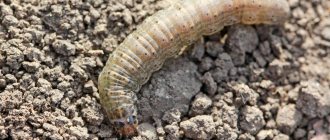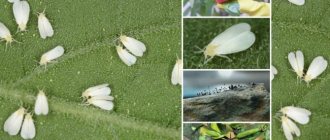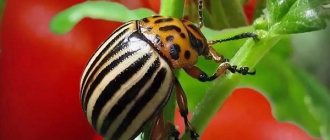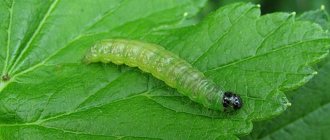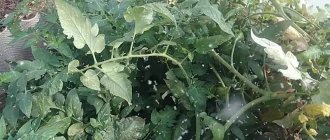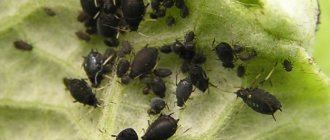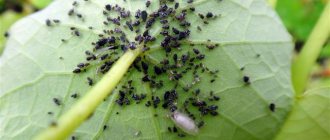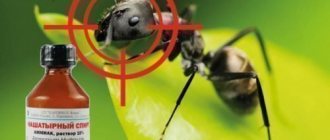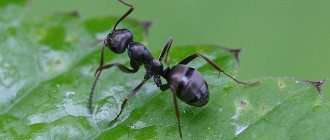The painstaking work of growing tomato seedlings, picking young bushes and transplanting plants to a permanent place is reduced to zero by pests that novice gardeners do not even notice. These invisible “enemies” are ordinary caterpillars on tomatoes. From the article you will learn how to properly deal with such a scourge.
Parasitic larvae on tomato beds
Not all types of caterpillars are attracted to juicy tomatoes. Tomatoes are most often parasitized by the larvae of two types of butterflies - whiteflies and cutworms. They actively eat the fruits and leaves of the plant. You can encounter pests not only in the open ground, but also in the greenhouse. It's not just the larvae that pose a danger. Butterflies damage tomatoes because they carry bacteria and viruses. Because of insects, plants begin to get sick.
This manifests itself in different ways:
- tomatoes stop growing;
- tomato fruits are deformed;
- The yield decreases due to the lack of ovary.
Whiteflies and cutworms can harm more than just tomatoes. They fly to neighboring vegetable crops. Insects pose a threat to zucchini, eggplant and sweet peppers.
Whitefly larvae
It is difficult to notice the pest on plant leaves. The size of the whitefly is only 1.5-3 mm. The body of the butterfly is white or yellowish, the wings are completely snow-white. The insect does not fly alone. Usually there are dozens of butterflies sitting on a branch. To detect them, you need to shake the plant trunk. The whiteflies will fly up, forming a white cloud.
Insect larvae are initially transparent, with a greenish tint. They feed on plant sap and live on the inside of leaves. During a cycle, the caterpillar goes through several stages. Young larvae are very mobile. They constantly move, destroying healthy and succulent leaves. Caterpillars secrete a sticky secretion that contains a lot of sugar. Because of this, the plant becomes infected with sooty fungus.
The foliage is covered with a black coating, which slows down the processes of photosynthesis. Without receiving the proper amount of sunlight, the plant gradually dies. Caterpillars on tomatoes spoil not only the foliage, but also the fruit. Tomatoes are covered with a white coating.
The liquid that whitefly caterpillars secrete attracts ants to the area. These insects can introduce aphids into the area, which can cause enormous harm to immature tomatoes.
When the caterpillar is ready to change into a butterfly, it slows down. The body of the insect is covered with a waxy coating. Instead of transparent, the color becomes light green. The green caterpillar on tomatoes in a greenhouse is resistant to chemicals. Treating tomatoes with pesticides and insecticides during this period will not bring results. The wax cover will protect the caterpillar from toxic compounds.
You should be wary of whiteflies when there is high humidity and air temperatures above 10 degrees. Caterpillars and butterflies die at the beginning of frost. But whitefly eggs survive cold weather. Butterflies deposit them in the upper layers of the soil, where the insect can remain until the next season.
Whiteflies live not only on tomatoes. Caterpillars can eat many indoor plants:
- begonias;
- fuchsia;
- balsams;
- passion flowers;
- pelargonium.
They pose a danger to potato beds and greenhouse peppers.
Armyworm larvae
The butterfly is a small moth of inconspicuous gray color. The insect's wingspan is less than half a centimeter. Butterflies lay eggs in the ground. Two weeks are enough for the larvae to emerge. The life cycle of a caterpillar before becoming a butterfly is 40 days. During this time, it causes significant damage to the crop.
Cutworms pose a threat to more than just tomatoes. Caterpillars eat beds of cabbage, beans, beets, rutabaga and eggplant.
Armyworm larvae, depending on the subspecies, may differ in color. Most caterpillars are green. There are individuals in brown-pink color. Their length does not exceed 30 mm.
The caterpillar eats tomatoes from the inside. It moves in tomato stems and also feeds on leaves. When the plant begins to wilt and the greens cease to be fleshy, the insect moves to the fruits. The gnawing subspecies of cutworm poses a danger to the root system of the plant. They can feed on underground areas of stems.
The cutworm caterpillar must be combated when the larva emerges from the egg. It is impossible to calculate this period in advance. After the caterpillar is born, there are several days during which it can be noticed on the plant. The caterpillar then chews through the tomato stem, making it very difficult to see.
A butterfly that lays worms on tomatoes - tomato cutworm: description, photo
There are many varieties of cutworms. Basically, they all differ in brown, gray or black color. The main activity occurs at night and evening hours. At this time, they eat leaves and damage all garden crops. It is worth noting that cutworms attack not only tomatoes, but also cabbage, cucumbers, beans and carrots. Cutworm caterpillars, which mainly live in the ground and eat the roots of plants, cause great harm. They also sometimes eat ground leaves that are very close to the ground.
Armyworm caterpillar
It is worth noting that the cutworm overwinters below ground and butterflies appear in the first half of May. They fly until the third ten days of July. The butterfly is very active. At night after an active summer, females lay eggs on weeds. It is worth noting that the female is very fertile. Therefore, if you do not control pests, you can lose your entire vegetable crop.
Owl butterfly
The garden armyworm is most common in Ukraine and the southern regions of Russia. There are two ways out, that is, two summers of butterflies. The first one falls in the month of May. The second year falls in August. Accordingly, almost all crops are susceptible to damage. Small, that is, the youngest caterpillars eat only the lower part of the leaves, giving them a skeletal appearance. Older caterpillars eat all the leaves completely, without even leaving veins, and also damage the fruits and form large, irregularly shaped hollows in them.
Owl butterfly
Reasons for appearance
Plants should be inspected for pests especially carefully in several cases:
- Humid climate. Heavy rains and hot air are ideal weather for caterpillars to hatch from eggs. The soil in which the masonry is located becomes warm enough, which becomes a signal for insects.
- Abundance of fruit crops. If there are areas with vegetable gardens and orchards near a summer cottage, there is a high probability of caterpillars appearing. Butterflies quickly move through the air and capture new territories.
- Weed grass. During the flowering period, weeds attract pests to the site.
- Poor soil treatment. Butterflies lay eggs in the ground. To destroy the masonry, you need to dig up the top layer of soil. The minimum processing depth is 15 cm.
Fine-grained insect netting will help get rid of caterpillars in a greenhouse. It will not allow butterflies inside, which will protect the plants from pests.
External manifestations of caterpillar activity
You can notice that pests have appeared on tomatoes based on several signs:
- The tomato leaves are covered with a white coating.
- Holes appear in green fruits.
- The foliage turns black, quickly dries out and falls off.
- The tomatoes turn dark brown and fall off the branches.
- At night, white and gray butterflies fly over the tomatoes.
You can check for caterpillars in your area using a butterfly trap. To make it, a regular plastic bottle with a narrow neck is suitable. Sweet fermented liquid is poured inside. Kvass, jam or berry compote will do. The trap is set at night. If in the morning there are several pest butterflies inside the jar, parasitic caterpillars have settled on the tomatoes.
Habitat
Carandrina inhabits a huge area, distributed throughout almost the entire territory of temperate and subtropical climates. Most often, the cutworm inhabits tomatoes:
- the European part of the Russian Federation;
- Southern Siberia;
- Urals;
- Far East;
- Baltic;
- Belarus;
- Ukraine;
- Moldova;
- Kazakhstan;
- Central Asia;
- China;
- Southern Europe;
- Africa;
- Australia;
- America.
How to spray tomatoes against pests?
To combat caterpillars on tomatoes, you can use several methods. Using insecticides, you can get rid of pests in one treatment. But using chemicals is dangerous during the fruit ripening period, since the poison can get into the food. If the first tomatoes appear on the plant, it is worth using traditional methods. They are not as effective, but are safe for humans.
Chemical insecticides
Treatment with toxic substances is carried out in emergency cases. It is advisable to resort to potent drugs when pests threaten most of the crop.
Effective insecticides against caterpillars include:
- "Inta-Vir". The drug can be used no more than 2 times per season.
- "Decis". The advantages of this product are fast action and lack of addiction in insects. Can be used once a season during active tomato growth.
- "Avant." Treatment should be carried out during the growing season of plant growth. It is recommended to water the area with the drug once a year. "Avant" destroys not only caterpillars, but also butterfly eggs in the ground.
- "Aktara". The drug is effective against one hundred species of insects. It poisons not only caterpillars, but also other common pests - aphids and the Colorado potato beetle.
Insecticides are removed from the plant naturally 30 days after spraying. It is not recommended to use them during the period when tomatoes bear fruit.
One preparation is not suitable for annual treatment. Insects quickly become immune to the composition of chemicals.
Organic preparations
Biological-based insecticides can be used several times per season. They are safe for humans, do not poison fruit crops and are not addictive to insects.
Organic preparations for protecting plants from caterpillars include:
- "Lepidocide." It repels butterflies and quickly kills caterpillars.
- "Aktofit". Two treatments with this product are carried out per season for optimal results.
- "Biostop". Effective in the fight against cutworms and aphids.
- "Fitoverm". For optimal results, the area is treated with the product twice during the spring-summer period.
- "Verticillin". The drug is made from a fungus that is toxic to insects. It quickly destroys butterflies and whitefly caterpillars.
Tomatoes after treatment with bioinsecticides can be harvested after a few days.
Folk recipes
Using improvised means, you can prepare an effective solution against pests. Spices have repellent properties. Such as salt or mustard. You can also reduce damage from caterpillars by poisoning the pests with a concentrated infusion of herbs.
Saline solution
To prepare the mixture, 400 g of table salt is dissolved in 5 liters of water. The composition is used to treat leaves, both from the outside and from the inside. To keep the salt on the surface of the plant longer, you can add shavings from laundry soap to the mixture.
Mustard powder solution
Dry mustard must be poured into boiling water. 100 g of powder is used per bucket of water. The solution is infused for 48 hours. Then you can spray it on infected plants.
Wormwood decoction
For 1 liter of boiling water there are 100 g of chopped weeds. The decoction is infused for 2 days. The resulting concentrate must be diluted with water in a ratio of 1:10.
Tobacco infusion
300 g of tobacco dust is poured into one bucket of boiling water. The solution is infused for a day. To make it last longer on the leaves, you need to add a third of the bar soap to the infusion.
Garlic water
Garlic has a detrimental effect on caterpillars. To make the solution, you need to chop 700 g of plant arrows and pour hot boiled water over them. The broth is infused in a closed container for a week. You need to use 50 g of concentrated infusion per bucket of water. The product can be sprayed on tomatoes once every 10 days.
A folk remedy for a hangover from the “piggy bank” of our ancestors or 8 best options
No. 1. Brine
For Russians, brine has become synonymous with the word “hangover.” It is with this remedy that many people treat themselves after a stormy feast. Why does brine help cure a hangover? It contains substances such as magnesium, potassium and sodium. It is these valuable elements that were lost by your body when excreting excess alcohol.
For brine to help with a hangover, you need to give preference to pickled vegetables: cabbage, tomatoes, cucumbers.
It is worth taking this folk remedy in an amount of no more than one glass, because it contains a lot of salt, which retains water. There is also a lot of acid in the brine, which is in excess in the body during a hangover. Therefore, excessive use of this drug can worsen your health.
No. 2. Tomato
Tomato juice and tomatoes themselves help saturate the body with vitamin C, potassium, sodium, acids and magnesium. This product improves stomach function.
Choose any folk remedy for a hangover using tomato:
| 1. | Add a pinch of ground red pepper to a glass of fresh tomato juice. This drink will help speed up your metabolism, which will allow you to remove toxins from your body faster. |
| 2. | Mix a glass of tomato juice in a blender with an egg and a pinch of salt. |
| 3. | A good hangover cure is a drink in which the ratio of tomato and kefir is 1:1. |
No. 3. Tea
To restore strength, it is better to use re-infusion rather than fresh. Add honey and lemon to your cup of tea to taste. If you experience vomiting and nausea during a hangover, then add ginger root to your tea. It helps improve stomach function.
No. 4. Eggs
An effective folk remedy for a hangover is a raw egg. The thing is that the white of a chicken egg prevents toxins from entering the blood. This property prevents a hangover from lasting for a long time.
Take note of this popular recipe:
- Shake 2 raw eggs
- add a pinch of salt,
- drink on an empty stomach.
You will notice the effect of this product literally after an hour.
No. 5. Dairy products
Any fermented milk product helps normalize stomach function, help restore the balance of minerals, speed up metabolism, quench thirst, and remove toxins.
Preference should be given to kefir, yogurt without additives, milk, curdled milk, fermented baked milk. It all depends on your personal preferences.
The use of this folk remedy has a number of indications:
- Sour milk should be at room temperature.
- It is better to take it immediately after waking up.
- You are allowed to drink no more than 700 ml per day.
- For the effect to be immediate, you do not need to mix fermented milk products with other foods.
No. 6. Bay leaf
Few people know that there is such a folk remedy for a hangover as a decoction of bay leaves.
It doesn’t matter at all whether you take dry or fresh leaves. This well-known nutritional supplement helps calm the nervous system, as well as cleanse the internal organs of poisons. Bay leaf has a sedative, diuretic, antiviral and antibacterial effect on the body.
Bay leaf has a sedative, diuretic, antiviral and antibacterial effect on the body.
To prepare a folk remedy for a hangover based on bay leaves, take 4 grams of the plant and 100 ml of water. This combination must be simmered for 10 minutes over low heat. Once the broth has cooled, divide it into equal portions and drink throughout the day. The maximum allowable volume is 2 glasses.
No. 7. Vitamin C
Lemon is a product accessible to absolutely every person. During a hangover, it helps get rid of nausea, speed up the processing of alcohol and the removal of toxins, eliminate headaches, normalize urination, and relieve fatigue.
There are two options for using it as a folk remedy for a hangover:
- The first is to eat lemon without sugar.
- If this option is not suitable for you, then simply add this product to mineral water. This drink perfectly quenches thirst and helps you forget about nausea.
What plants repel caterpillars?
Pests will avoid places where bird cherry bushes grow. Many useful and medicinal plants repel caterpillars:
- mint;
- calendula;
- coriander;
- sage;
- thyme;
- thyme.
Butterflies are afraid of strong odors. Cutworms and whiteflies are repelled by certain types of flowers, such as geraniums, cornflowers and marigolds.
Advice! At the beginning of spring, white mustard seeds can be planted in future tomato beds. When the plant sprouts, it will saturate the ground with its scent. After this, the soil is loosened and tomato seedlings are planted. Butterflies will not be able to lay eggs in such soil.
Other ways to fight
To repel cutworms, repellent plants can be planted between tomato beds, as well as along the perimeter of the plot. These include calendula, cilantro and basil. They have a distinct aroma that repels cutworms and other insect pests.
Some vegetable growers collect cutworm caterpillars by hand. But this method can only be used with a small number of tomato bushes. In a large garden, manual collection of pests becomes impossible.
Biological preparations Bitoxibacillin, Lepidocid, Actofit, Agravertin are considered effective means for exterminating adult cutworms and their caterpillars. Bitoxibacillin is a highly effective microbiological insecticide designed to combat all lepidopteran insects on the site. The solution is prepared in the proportion specified in the instructions. Treatment with Bitoxibacillin is carried out at intervals of 8 days.
Biological methods
In nature, the enemies of pest caterpillars are Trichogramma. They lay eggs in the cocoons of butterflies, thereby destroying garden pests. Insects can be purchased at a special store. They are released onto tomato bushes 3 times per season. It is necessary to plant 5000 trichograms per 1 hectare of land.
Bracones pose a danger to caterpillars. These are predatory flies that parasitize the larvae of other insects. The females pierce the caterpillar's cover and inject poison, which stops the digestive system. Then the adult injects about 20 larvae into the victim’s body. Bracons eat the caterpillar from the inside until they reach adulthood.
Harm of cutworms
The potential fertility of the cutworm is 2 thousand eggs. It is especially unpleasant that some species lay one butterfly per leaf, and one butterfly can infect a huge area. Other cutworms can leave 300 or more eggs on the underside of a tomato leaf blade.
During the day, the larvae hide under leaves or plant litter, and feed in the evening and at night. Cutworm - crop pests are conventionally divided into three groups:
- leaf-eaters, whose food base is tomato leaves;
- gnawing cutworms damage the roots and lower part of tomato shoots, most belong to the Agrotis subfamily;
- intrastem ones gnaw into soft tissue, live and feed inside the plant until the time comes to pupate.
But it’s not for nothing that moths are called omnivores. Caterpillars in the early stages of development usually skeletonize and gnaw tomato leaves. Then they may well move onto tomato fruits, damaging them in the area of the stalk. Gnawing cutworms prefer not to rise high; they feed on flowers and tomatoes if they lie on the ground.
How to properly process tomatoes?
Proper care of tomatoes reduces the risk of caterpillars appearing on the site. Plant processing methods differ depending on the location where the fruit crops are located.
Outdoors
The larvae can infect the soil when planting seeds that have parasites. To prevent this from happening, you should always treat the seedlings. The disinfection solution is prepared on the basis of potassium permanganate. For 1 liter of water, 1 mg of the product is used. The seeds are placed in the solution for 15 minutes. Afterwards they are washed thoroughly. They can then be sprouted or dried and used later.
Sprinkling the soil with tobacco dust will help control caterpillars on the site. The eggs of butterflies will die in it, due to which the population of larvae will decrease. If few insects are noticed, it is worth spraying the leaves with herbal infusion. Every other day you can wash off the sticky sweet coating that is secreted by several species of larvae. In this way, you can protect the plant from the formation of fungus.
In case of massive insect infestation, it is worth using organic or chemical preparations for treatment.
In greenhouses and greenhouses
There are many butterfly traps you can set up in an enclosed area. Sticky fly strips will help reduce the number of insects. You can also lay out sheets of plywood or boards coated with a sticky and sweet solution in the greenhouse.
It is only possible to completely get rid of caterpillars in a greenhouse using insecticides. It is important to follow the processing instructions so as not to exceed the permissible amount of chemicals.
Useful tips and advice
It is not advisable to plant tomatoes too close to each other. Because of this, it is convenient for pests to move to neighboring plants, and their population grows rapidly.
Tomatoes need daily watering. The soil must be moistened moderately so as not to create a favorable environment for caterpillars to reproduce. Tomatoes are watered early in the morning, when the sun has not yet had time to warm the ground. Water should only be poured at the root of the plant. It is also advisable to water the soil in winter. Because of this, insect pupae that are in the ground die.
Prevention measures
To prevent larvae from appearing on the site, it is necessary to carefully monitor the seedlings. The likelihood of parasites appearing is low if:
- the top soil of the earth is completely replaced at the end of autumn;
- in spring the soil is treated with boiling water or a weak solution of potassium permanganate;
- there are no weeds in the garden;
- the greenhouse windows are protected with fine-grained mesh;
- In autumn, tomato tops are completely removed from the site.
The invasion of caterpillars can be easily stopped if measures are taken in time and the fruit plants are treated. Timely prevention will help reduce the number of pests on the site.
Signs of defeat
The cutworm butterfly can only be seen at night. But its presence in a tomato plot is not difficult to notice:
- If you look closely at the underside of tomato leaves, you can see eggs. If there are not many insects, then searching for oviposition may be difficult;
- the lower leaves on the tomato bushes, and then the upper ones, become scabbed. The caterpillar eats away the soft tissue of the leaf blade, but the vein remains. So she moves from the lower leaf to the upper one, leaving behind the skeletons of the leaves;
- You can catch the caterpillar eating and examine it late in the evening, when it has already climbed up the shoot to the leaf;
- if there are a lot of insects, then the tomato plantings look gloomy: the leaves and buds are worn out, the fruits are holed. Further, the caterpillar becomes more and more voracious and the tomatoes become covered with eaten holes;
- the gnawed leaf begins to turn black and dry out;
- large brown tomatoes are trying to heal, but they have little success. The process of decay begins.

